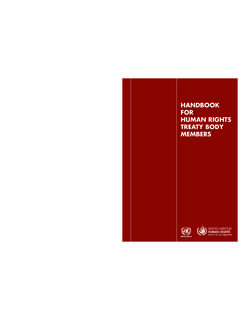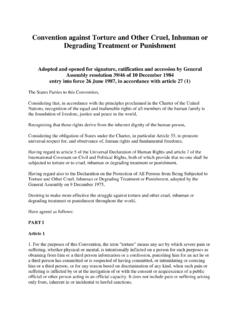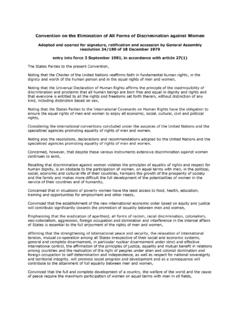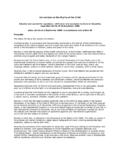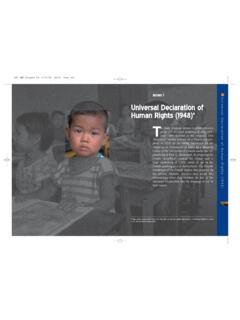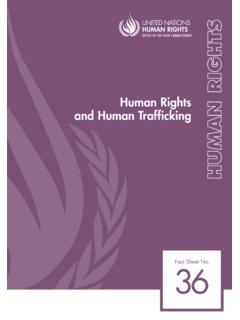Transcription of General comment No. 14: The right to the highest …
1 CESCR General comment No. 14: The right to the highest Attainable Standard of Health (Art. 12) Adopted at the Twenty-second Session of the Committee on Economic, Social and Cultural rights , on 11 August 2000 (Contained in Document ) 1. Health is a fundamental human right indispensable for the exercise of other human rights . Every human being is entitled to the enjoyment of the highest attainable standard of health conducive to living a life in dignity. The realization of the right to health may be pursued through numerous, complementary approaches, such as the formulation of health policies, or the implementation of health programmes developed by the World Health Organization (WHO), or the adoption of specific legal instruments.
2 Moreover, the right to health includes certain components which are legally The human right to health is recognized in numerous international instruments. Article of the Universal Declaration of Human rights affirms: Everyone has the right to a standard of living adequate for the health of himself and of his family, including food, clothing, housing and medical care and necessary social services . The International Covenant on Economic, Social and Cultural rights provides the most comprehensive article on the right to health in international human rights law. In accordance with article of the Covenant, States parties recognize the right of everyone to the enjoyment of the highest attainable standard of physical and mental health , while article enumerates, by way of illustration, a number of steps to be taken by the States parties.
3 To achieve the full realization of this right . Additionally, the right to health is recognized, inter alia, in article 5 (e) (iv) of the International Convention on the Elimination of All Forms of Racial Discrimination of 1965, in articles (f) and 12 of the Convention on the Elimination of All Forms of Discrimination against Women of 1979 and in article 24 of the Convention on the rights of the Child of 1989. Several regional human rights instruments also recognize the right to health, such as the European Social Charter of 1961 as revised (art. 11), the African Charter on Human and Peoples rights of 1981 (art. 16) and the Additional Protocol to the American Convention on Human rights in the Area of Economic, Social and Cultural rights of 1988 (art.)
4 10). Similarly, the right to health has been proclaimed by the Commission on Human rights ,2 as well as in the Vienna Declaration and Programme of Action of 1993 and other international 1 For example, the principle of non-discrimination in relation to health facilities, goods and services is legally enforceable in numerous national jurisdictions. 2 In its resolution 1989/11. 3 The Principles for the Protection of Persons with Mental Illness and for the Improvement of Mental Health Care adopted by the United Nations General Assembly in 1991 (resolution 46/119) and the Committee s General comment No. 5 on persons with disabilities apply to persons with mental illness; 3.
5 The right to health is closely related to and dependent upon the realization of other human rights , as contained in the International Bill of rights , including the rights to food, housing, work, education, human dignity, life, non-discrimination, equality, the prohibition against torture, privacy, access to information, and the freedoms of association, assembly and movement. These and other rights and freedoms address integral components of the right to health. 4. In drafting article 12 of the Covenant, the Third Committee of the United Nations General Assembly did not adopt the definition of health contained in the preamble to the Constitution of WHO, which conceptualizes health as a state of complete physical, mental and social well-being and not merely the absence of disease or infirmity.
6 However, the reference in article of the Covenant to the highest attainable standard of physical and mental health is not confined to the right to health care. On the contrary, the drafting history and the express wording of article acknowledge that the right to health embraces a wide range of socio-economic factors that promote conditions in which people can lead a healthy life, and extends to the underlying determinants of health, such as food and nutrition, housing, access to safe and potable water and adequate sanitation, safe and healthy working conditions, and a healthy environment. 5. The Committee is aware that, for millions of people throughout the world, the full enjoyment of the right to health still remains a distant goal.
7 Moreover, in many cases, especially for those living in poverty, this goal is becoming increasingly remote. The Committee recognizes the formidable structural and other obstacles resulting from international and other factors beyond the control of States that impede the full realization of article 12 in many States parties. 6. With a view to assisting States parties implementation of the Covenant and the fulfilment of their reporting obligations, this General comment focuses on the normative content of article 12 (Part I), States parties obligations (Part II), violations (Part III) and implementation at the national level (Part IV), while the obligations of actors other than States parties are addressed in Part V.
8 The General comment is based on the Committee s experience in examining States parties reports over many years. 1. Normative content of article 12 7. Article provides a definition of the right to health, while article enumerates illustrative, non-exhaustive examples of States parties obligations. 8. The right to health is not to be understood as a right to be healthy. The right to health contains both freedoms and entitlements. The freedoms include the right to the Programme of Action of the International Conference on Population and Development held at Cairo in 1994, as well as the Declaration and Programme for Action of the Fourth World Conference on Women held in Beijing in 1995 contain definitions of reproductive health and women s health, respectively.
9 Control one s health and body, including sexual and reproductive freedom, and the right to be free from interference, such as the right to be free from torture, non-consensual medical treatment and experimentation. By contrast, the entitlements include the right to a system of health protection which provides equality of opportunity for people to enjoy the highest attainable level of health. 9. The notion of the highest attainable standard of health in article takes into account both the individual s biological and socio-economic preconditions and a State s available resources. There are a number of aspects which cannot be addressed solely within the relationship between States and individuals; in particular, good health cannot be ensured by a State, nor can States provide protection against every possible cause of human ill health.
10 Thus, genetic factors, individual susceptibility to ill health and the adoption of unhealthy or risky lifestyles may play an important role with respect to an individual s health. Consequently, the right to health must be understood as a right to the enjoyment of a variety of facilities, goods, services and conditions necessary for the realization of the highest attainable standard of health. 10. Since the adoption of the two International Covenants in 1966 the world health situation has changed dramatically and the notion of health has undergone substantial changes and has also widened in scope. More determinants of health are being taken into consideration, such as resource distribution and gender differences.
